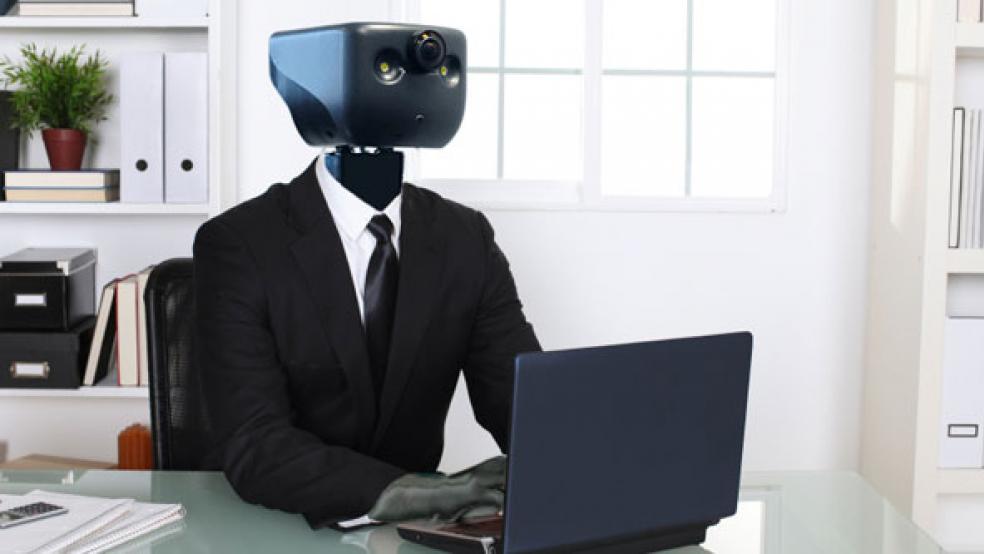It sounds like the stuff of science fiction, but robots could be strolling past you as you make your way out to lunch.
The fight for market share in the small but growing field of telepresence has begun. Much more than videoconferencing tools like Skype, telepresence allows a person with the aid of robotics to feel as if they were present and to give the appearance of being present in a different location.
First up is the Ava 500, from iRobot. The company has sold 10 million vacuum cleaning robots worldwide and its defense devices have helped organizations across the globe, including the police during the Boston bombings. After 14 years and five prototypes, the company is about to release its first telepresence robot to the public in early 2014.
RELATED: 10 JOBS THAT WON'T BE TAKEN BY ROBOTS ... YET
"We had to get all of these human factors right," CEO Colin Angle told CNBC at the 2013 IFA (Internationale Funkausstellung Berlin) Trade Fair. "So that means the quality of the audio, the quality of the video, the ability to project emotion and read other people's faces. If we're sitting down I need to be looking at you eye to eye."
Using a tablet computer and some third party video software, iRobot's idea allows users to undock a robot in a remote office and navigate - either automatically or manually - to a desired location in that office. Using its partnership with Cisco, Angle said it can deliver "best in class VOIP (Voice over Internet Protocol) experience" via a monitor on top of the robot, allowing colleagues to talk to one another.
It effectively allows business professionals to "teleport" to different locations, Angle said, and features enterprise grade security. Angle uses the technology to find his colleagues in the office and have eight-hour conversations. He said he would even look to use the robot exclusively for half a day every two weeks, and even deliver his keynote speech at next year's IFA event using the device.
RELATED: 7 ROBOTS IN THE WORKPLACE
"I'm trying to give you the experience you would have if you were there in person," he said. "It could be bigger than everything else that we've done. Easily." Pricing, yet to be finalized, looks set to be fixed at $2,500 for a monthly lease or $70,000 for a full purchase.
"QX will have several configurations of hardware and will sell in a variety of prices from less than $10,000, up to about $17,000 depending on the video conferencing hardware chosen," Bill Murvihill, a business development exec from Anybots, told CNBC. QX enables customers to drive remotely through the space that it's in, he said, adding that it can be expanded easily for retail, education, manufacturing and other applications.
Anybot even allows interested parties to test drive its previous model, the QB, on its website.
VGo, Robodynamics and Willow Garage are just a few of the companies ready to compete in this market with their own models.
Mark Bunger, a research director at Lux Research told CNBC that the different robots are an interesting intermediate step between non-mobile telepresence and fully autonomous robots.
"They are essentially land-based drones, using human vision and decision-making to substitute for machine vision and artificial intelligence," he said. "They will probably be popular in some niche applications (such as bedside telemedicine and remote inspection of inaccessible/dangerous places) but mostly they'll be an office novelty at technophile companies."
Other firms making inroads in the sector are Romotive and Double Robotics, according to Bunger. Using simpler and cheaper technology these two different devices allow users to effectively drive a smartphone or a tablet remotely using robotic wheels.
"I think these are especially interesting because they use last-generation/obsolete mobile devices (smartphones, tablets) to provide vision, user interface, connectivity, etc," Bunger said. "It's a very smart strategy because it is modular – as the mobile devices improve, the rest of the robot can easily be 'upgraded'. And it's much cheaper than developing all that functionality from scratch."
This article originally appeared on CNBC.
Read more at CNBC:
Robot Revolution: How to Stay Calm and Make Money
The Robot Reality: Service Jobs Are Next to Go
Hi Tech Robots and Hair-Raising Tricks





